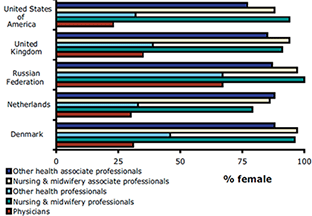Resource Spotlight: Gender and Health Workforce Statistics

Women make up about 42% of the estimated global paid working population. Within the health sector, in many countries women comprise over 75% of the workforce, making them indispensable as contributors to the delivery of health care services. However, in many countries, women still tend to be concentrated in the lower-status health occupations, and to be a minority among more highly trained professionals. The under-representation of women in managerial and decision making positions may lead to less attention to and poorer understanding of both the particular features of working conditions that characterize much of women’s employment, and the health care needs specific to women. In many contexts, access to female providers is an important determinant of women’s health service utilization patterns. Omission of gender considerations may also lead to inadequate health system responsiveness to the needs of men: for example, reproductive health services are often not set up so as to encourage male involvement.
Gender analysis of the health workforce may reveal that health systems themselves can reflect or even exacerbate many of the social inequalities they are meant to address and be immune from. Participatory approaches in health workforce planning, development and management should be ensured, where both women and men health workers are given an active role to ensure that research being undertaken is relevant to their needs and interests. Research, policy and program efforts to address gender equality in the health workforce should lead to strengthened health systems more broadly. [from author]
View this resource.
The HRH Global Resource Center has other resources on this topic including:
- Integrating Gender in Human Resources for Health (HRH) Projects
- Human Resources for Health: a Gender Analysis
- Unequal, Unfair, Ineffective and Inefficient: Gender Inequity in Health: Why It Exists and How We Can Change It
For additional resources on this topic, visit the Gender Issues and Gender Policy subject categories.
Past Resource Spotlights
- 8542 reads




